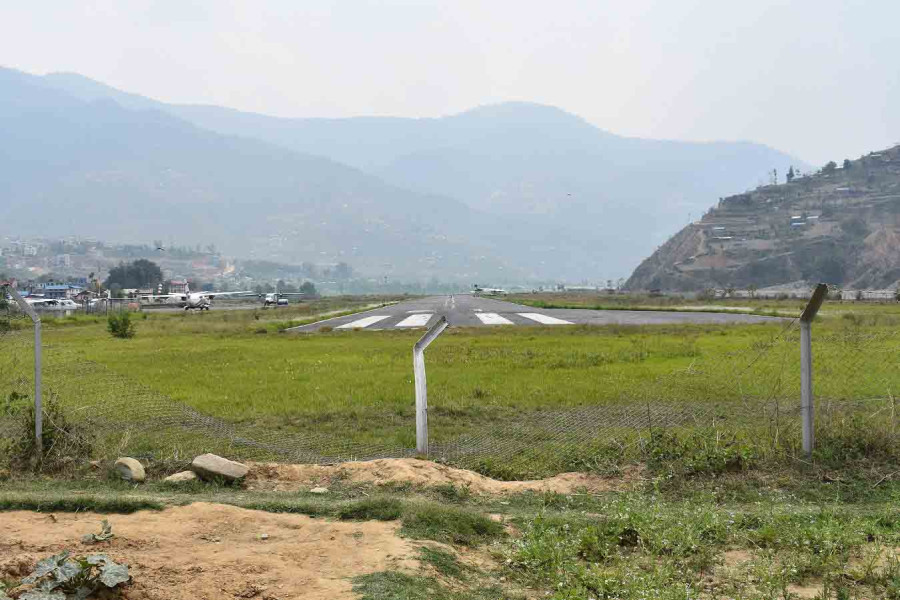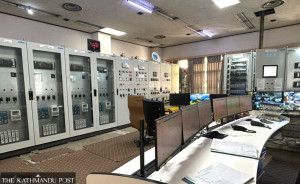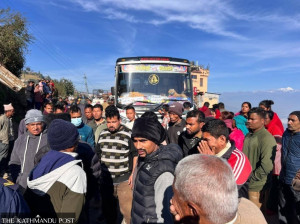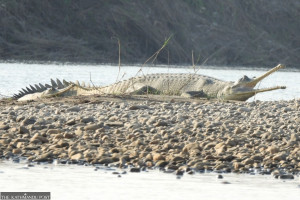Bagmati Province
For Everest enthusiasts, an unpleasant experience awaits at Manthali airport
The Ramechhap airport, which now conducts around 85 flights daily, is severely underequipped to handle the hundreds of tourists who arrive and leave every day.
Tika Prasad Bhatta
Until a few years ago, the Ramechhap airport at Manthali was a grassland. The airport, built by villagers in 1979 by contributing their labour, had nearly closed after Nepal Airlines stopped flying there a decade ago. In 2015, the runway was upgraded from grass to concrete and test flights were conducted in August 2016. Before being blacktopped, the airport used to see about 10 flights per day for cargo operations. But except for a few flights every year, the airport was all but dead.
But early this year, the airport sprang back to life. In order to ease congestion at Tribhuvan International Airport and facilitate ongoing runway repair works, all Lukla flights were rerouted to fly from Manthali. An airport that had barely seen a dozen flights in the last decade began to handle 85 flights daily, and it was ill-equipped to deal with the hundreds of tourists arriving daily. The airport lacks proper parking, a waiting room, toilets and even a restaurant.
“Every airport has a waiting room but Manthali airport is an exception. There are no refreshment bars for even a cup of tea,” said Philip, an American tourist on his way to Lukla. “I finally crossed the security check area, which is outside the airport building, and had to wait for hours by the airport fence before my plane arrived.”
According to airport officials, during the peak tourist seasons of March to May and September to November, the airport sees more than 800 tourists arrive and depart via the airport daily.
“But we don’t even have basic infrastructure like proper ticket counters for tourists flying out of the airport,” said Amit Chaurasia, head of the Ramechhap Civil Aviation Office. “The Civil Aviation Authority of Ramechhap has not been able to designate space for airlines to set up their counters, so passengers get their tickets checked outside the terminal building.”
After getting their tickets checked, passengers must wait by the airport fencing, as there is no proper waiting area with seats. According to Chaurasia, a few chairs have been installed and they plan to set up a temporary waiting room in a grassy field outside the terminal.
There are fears that the airport infrastructure itself may not be equipped to handle the large volume of flights.
In April, a plane belonging to Tara Air hit a fence around 50 metres ahead of the runway approach while landing, causing the pilot to lose control. The plane then hurtled towards the runway before slipping into a grassy area to the right of the airstrip. A preliminary report suggested that the accident, where there was no casualty, was due to a lack of lights on the runway.
The municipality of Manthali, where the airport is located, is also not equipped to deal with the number of tourist arrivals in the area. There are not enough hotels for tourists to stay overnight before they catch their flights to Lukla the next day.
“All the decent hotels in Manthali are prebooked by airlines staff,” said Mohan Khatri, a local. “They come here during the peak seasons when the airport is operational and stay at hotels in the area. This leaves little room for tourists.”
According to locals, no one has paid much attention to tourism development in the area as visitors only arrive during the peak tourist season and the city is dry during offseason.
“Since the airport is only in operation during the climbing season, the rest of the year sees very few tourists in the area,” said Khatri. “So there hasn’t been much development in terms of infrastructure and hotels catering to tourists.”
Suresh Udash, a member of the Ramechhap Chamber of Commerce, said that even local businesspersons are not interested in building tourism-related infrastructure, given that tourism in the area is seasonal.
“Locals do not feel encouraged to invest in hotels and lodges because they don’t know if the airport will even be in operation once the climbing season ends,” said Udash. “If the airport is closed for the rest of the year then the businesses will also dry out for a lack of tourists.”
Facilities at the airport and in Manthali can only be improved if there is a promise of return on investment, say locals.
“The government will have to guarantee business to local business operators throughout the year for us to be able to invest,” said Khatri.
If the Civil Aviation Authority’s plans to make Manthali airport a permanent hub for Lukla flights materialise, there is hope for local businesses. A permanent shift of Lukla flights to Manthali will ease pressure from Tribhuvan International Airport by at least 90 takeoffs and landings per day.
“We want to shift Lukla flights from Kathmandu permanently,” said Rajan Pokhrel, director-general of the Civil Aviation Authority of Nepal. “We have started preparing a master plan for the airport and upgradation works will start soon.”
According to Pokhrel, the private operators were initially hesitant to fly from Manthali but they are much happier now.
“At Kathmandu airport, they had to wait for minutes and sometimes hours to take off. At Manthali airport, they fly 12 times in the time it would take for one flight from Kathmandu airport,” he said.
Manthali, 132 km from Kathmandu, is a five-hour drive from the Capital. Situated at an elevation of 474 metres, the airport has a 518-metre runway. Back in April, air service to Lukla was temporarily moved to Manthali Airport from Kathmandu's Tribhuvan International Airport due to the works to renovate the runway at the international airport. From September 1, Kathmandu airport has been closed every day from 11:30 pm to 6:30 am due to work on the taxiway. The seven-hour closure will continue until the end of the year.




 16.12°C Kathmandu
16.12°C Kathmandu (1).jpg)











%20(1).jpg&w=300&height=200)

